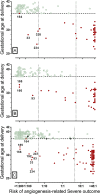Modeling risk for severe adverse outcomes using angiogenic factor measurements in women with suspected preterm preeclampsia
- PMID: 25641027
- PMCID: PMC4409832
- DOI: 10.1002/pd.4554
Modeling risk for severe adverse outcomes using angiogenic factor measurements in women with suspected preterm preeclampsia
Abstract
Introduction: Preeclampsia (PE) is a pregnancy-specific syndrome associated with adverse maternal and fetal outcomes. Patient-specific risks based on angiogenic factors might better categorize those who might have a severe adverse outcome.
Methods: Women evaluated for suspected PE at a tertiary hospital (2009-2012) had pregnancy outcomes categorized as 'referent' or 'severe', based solely on maternal/fetal findings. Outcomes that may have been influenced by a PE diagnosis were considered 'unclassified'. Soluble fms-like tyrosine kinase (sFlt1) and placental growth factor (PlGF) were subjected to bivariate discriminant modeling, allowing patient-specific risks to be assigned for severe outcomes.
Results: Three hundred twenty-eight singleton pregnancies presented at ≤34.0 weeks' gestation. sFlt1 and PlGF levels were adjusted for gestational age. Risks above 5 : 1 (10-fold over background) occurred in 77% of severe (95% CI 66 to 87%) and 0.7% of referent (95% CI <0.1 to 3.8%) outcomes. Positive likelihood ratios for the modeling and validation datasets were 19 (95% CI 6.2-58) and 15 (95% CI 5.8-40) fold, respectively.
Conclusions: This validated model assigns patient-specific risks of any severe outcome among women attending PE triage. In practice, women with high risks would receive close surveillance with the added potential for reducing unnecessary preterm deliveries among remaining women. © 2015 The Authors. Prenatal Diagnosis published by John Wiley & Sons Ltd.
© 2015 The Authors. Prenatal Diagnosis published by John Wiley & Sons Ltd.
Figures





References
-
- Organization WH. 2005. World Health Report. Make every mother and child count. Geneva.
-
- Friedman SA, Schiff E, Kao L, et al. Neonatal outcome after preterm delivery for preeclampsia. Am J Obstet Gynecol. 1995;172:1785–8. discussion 1788–1792. - PubMed
-
- Thangaratinam S, Gallos ID, Meah N, et al. How accurate are maternal symptoms in predicting impending complications in women with preeclampsia? A systematic review and meta-analysis. Acta Obstet Gynecol Scand. 2011;90:564–73. - PubMed
-
- Thangaratinam S, Ismail KM, Sharp S, et al. Accuracy of serum uric acid in predicting complications of pre-eclampsia: a systematic review. BJOG. 2006;113:369–78. - PubMed
-
- Thangaratinam S, Koopmans CM, Iyengar S, et al. Accuracy of liver function tests for predicting adverse maternal and fetal outcomes in women with preeclampsia: a systematic review. Acta Obstet Gynecol Scand. 2011;90:574–85. - PubMed
Publication types
MeSH terms
Substances
Grants and funding
LinkOut - more resources
Full Text Sources
Other Literature Sources
Medical
Miscellaneous

